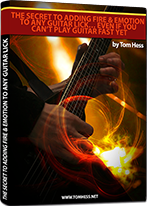Improving Your Guitar Phrasing – Part II
Emotion To Any Guitar Lick

EMAIL TO GET ACCESS
By submitting your info, you agree to send it to Tom Hess Music Corporation who will process and use it according to their privacy policy.
Emotion To Any Guitar Lick

EMAIL TO GET ACCESS
By submitting your info, you agree to send it to Tom Hess Music Corporation who will process and use it according to their privacy policy.
Contrast that approach with a mature player who is, in fact, a virtuoso, but elects to communicate with his audience. For sure, there will be flurries of wonderfully advanced playing – fast runs, lightning-quick arpeggios, etc, but this will be balanced with musical passages containing beautiful vibrato, emotional note bending, and rhythmic variation.
I’m not saying that fast, virtuoso playing is unemotional. It certainly is very emotional and passionate at times, and is a wonderful tool for self-expression. However, it is only one piece of the puzzle. One of the biggest problems some inexperienced players have is that they use their technical skill to cover up their poorly developed guitar phrasing skills. In other words, they play fast constantly to try to mask the fact that they lack the necessary skills to truly communicate and express themselves. This is a shame, but it is correctable.
Okay, so hopefully you’ve decided that you do not want to be a guitarist who talks “at” his audience with very little to say. Let’s try this breathing exercise together. The point of this is to demonstrate that there is an inherent natural flow to effective communication. There must be words, notes, and substance, but there also must be space and rest.
Step 1: Take a seat in your usual practice space. You should be sitting upright so that you can breathe properly. Inhale deeply as you would when you are getting ready to say something important. As you exhale, try and sing a little melody until you run out of breath. Give this a try before continuing.
Did you do it? Most likely, your melody wasn’t very long. Don’t worry if it wasn’t the greatest melody in the world. Perhaps it wasn’t even an original melody... that doesn’t matter.
Step 2: Repeat Step 1 four (4) times in succession. The 1st time, sing a melody. Then pause, and inhale. As you exhale, make your 2nd melody an attempt to “answer” your 1st one. The 3rd time, sing another new melody, and the 4th time, attempt to answer the 3rd melody. This process is called “call and response.” Many great blues guitar players and singers have mastered this technique.
If you’ve done this, you now have four (4) bars of naturally flowing music that you composed, and you didn’t even touch your guitar.
Practice doing this in as many music situations as possible. Here are a few possibilities: the next time you are composing a song or melody, try this breathing method first. Sing your melodies along with the chords. Do this over and over until you find a melody you like. Then grab your guitar and learn the notes. Also, be creative with this exercise; don’t just blandly spit out a melody. Use different rhythmic groupings, inflections, and dynamics. Use your imagination!
Another valuable thing you can do is study the guitar phrasing styles of other guitarists. You should also spend time studying artists of other instruments, but for now, let’s stick to guitarists.
 Play Guitar Solos Like The Pros
Play Guitar Solos Like The ProsFind out how to play great guitar solos by using guitar phrasing.
 Make Guitar Licks Sound Intense
Make Guitar Licks Sound IntenseLearn how to add tons of tension
to your lead guitar solo phrases.
 Play Cool Legato Guitar Phrases
Play Cool Legato Guitar PhrasesImprove your guitar phrasing by
playing these cool legato licks.
- At (CD time) 2:05, the solo begins with a Chuck Berry-style phrase which has been “Van Halen’ized”. Notice the bent note at 2:08 which serves as a kind of “pause” before the flurry of notes to follow from 2:09 to 2:11.
- Notice the bend at 2:11 which is the end of the preceding phrase, and serves as another short pause in the action.
- The next phrase from 2:12 to 2:15 has all kinds of guitar phrasing ideas, using tapped notes on bends
- Check out the staccato phrasing and rhythm of the line beginning at 2:16 and leading into the breakdown section at 2:18.
- From 2:19 to 2:53, we hear Eddie playing some very seductively laid-back phrases, using a mixture of lead and rhythm guitar passages. Notice the effect this passage has upon you. For me, this section is perfect, because it balances out all of the many notes that preceded it, and contains some very vocal-like phrasing.
Nick Layton is a professional guitarist/composer living in Vancouver, WA. His debut CD entitled Storming the Castle is available now and features epic metal songwriting and virtuoso guitar playing. Visit: nicklayton.com and send questions/comments to nick@nicklayton.com
Transform your lead guitar playing skills with the best online electric guitar lessons.

